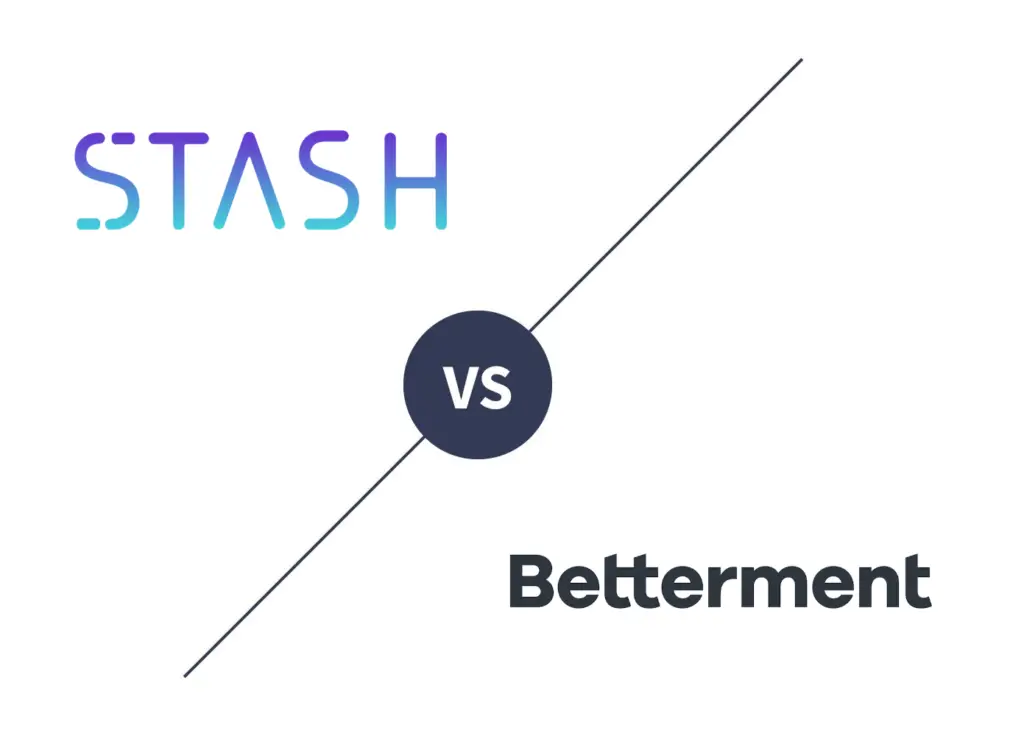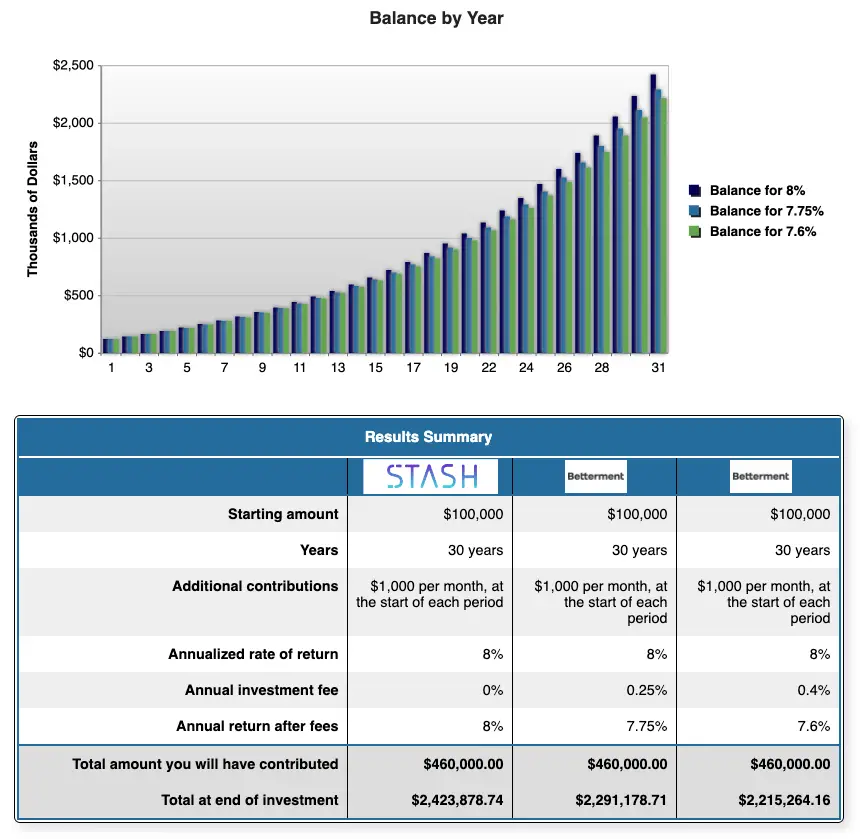
Modern, tech-driven platforms like Stash and Betterment have grown in popularity recently with low fees, simplicity, convenience, and intuitive apps and interfaces, especially among young, new investors. Here we’ll compare Stash and Betterment.
Disclosure: Some of the links on this page are referral links. At no additional cost to you, if you choose to make a purchase or sign up for a service after clicking through those links, I may receive a small commission. This allows me to continue producing high-quality, ad-free content on this site and pays for the occasional cup of coffee. I have first-hand experience with every product or service I recommend, and I recommend them because I genuinely believe they are useful, not because of the commission I get if you decide to purchase through my links. Read more here.
Stash vs. Betterment – Summary Comparison
Contents
Stash vs. Betterment – Commissions and Fees
Neither Stash nor Betterment has commissions on trades. You still have to pay the unavoidable expense ratios on the ETF’s (exchange traded funds) in which you’re invested with both platforms.
Stash has 3 tiered account levels with different fees and features:
- All 3 account levels have a taxable investment account and a bank account.
- Their Beginner plan at $1/mo. is just a taxable investment account.
- The Growth plan at $3/mo. includes access to retirement accounts in the form of a Traditional or Roth IRA.
- The Stash+ plan is $9/mo. and adds access to custodial accounts to invest for 2 kids, a metal card for the bank account, and a monthly market insights report.
Betterment carries a 0.25% annual fee for their basic plan and a 0.40% annual fee for their Premium plan. The Premium plan includes professional investing advice and financial planning advice, and requires a minimum invested balance of $100,000.
These annual fees are based on a percentage of your invested balance, also known as assets under management (AUM). For balances above $2M, you receive a 0.10% discount, reducing the basic fee to 0.15% and the Premium fee to 0.30%.
Betterment’s fees look extremely low at first glance, but let’s examine how they affect a portfolio’s value over time:

Using a starting balance of $100,000, $1,000 contributed monthly over 30 years, and an annualized rate of return of 8%, Betterment’s 0.25% fee costs you $132,700 in fees. The Premium 0.40% fee costs you $208,615 in fees.
Notice how the value differences become more pronounced near the end of the investing horizon when the account value is larger. Such is the power of compound interest, in this case unfortunately working against you.
So Stash clearly wins on fees.
Stash vs. Betterment – Account Types
Stash offers these account types:
- Individual (Taxable)
- Traditional IRA
- Roth IRA
- Rollover IRA
- Custodial
Betterment offers these account types:
- Individual (Taxable)
- Traditional IRA
- Roth IRA
- Rollover IRA
- Joint
- Trust
Neither platform offers:
- SIMPLE IRA
- Solo 401(k)
- 529
- HSA
- Non-Profit
Stash vs. Betterment – Investment Products
Stash is not a true robo-advisor. Stash allows you to invest in individual stocks and a handful of ETF’s (Exchange Traded Funds) of your choosing. They do also have 4 ETF’s from iShares that they call “Diversified Mixes” which are not unlike the pre-built portfolios from Betterment, but these are in ETF form directly from iShares and may have a higher expense ratio than the average expense ratio of the ETF's inside your Betterment portfolio. These 4 are called Aggressive Mix, Conservative Mix, Long-Term Mix, and Moderate Mix. The respective tickers are AOR, AOK, AOA, and AOM. You can read about these funds on the iShares website if you’re curious. In this sense, either platform allows you to be hands-off if you want. You can view the full list of ETF’s from Stash here.
Betterment provides research-backed, expert-built, globally diversified portfolios based on modern portfolio theory. They are comprised of low-cost ETF's and are based on your risk tolerance. This obviously limits your investing customization options, but allows you to be completely hands-off in your investing.
Neither platform offers mutual funds, options, futures, forex, or cryptocurrency trading.
Stash vs. Betterment – Mobile App
Betterment has a sleek, modern, intuitive, robust mobile app for both Apple iOS and Android. Stash has an excellent app too, but some Android users specifically seem to complain of problems with the app.
Here are some screenshots of the Stash app:

Here are some screenshots of the Betterment app:

Stash vs. Betterment – Extra Features
- Both Stash and Betterment offer FDIC-insured checking accounts with a debit card, making them financial suites rather than just investment brokers. Betterment offers a separate savings account with a 0.40% APY. Stash’s bank account earns you additional shares of stock as part of their Stock-Back® program.
- Both Stash and Betterment have some basic educational resources via their blogs related to investing and personal finance. Stash’s premium Stash+ plan at $9/mo. also gets you a monthly market insights report.
- Betterment accounts feature automatic rebalancing, which keeps your portfolio's target allocations on track.
- Stash lets you access your direct deposits up to 2 days early, stating that you can “get paid up to 2 days early.”
- Both Stash and Betterment offer fractional shares, a feature that allows every penny to go to work for you faster. This means you can buy a fraction of a share of your investments. For example, if one single share costs $100 and you only have $10 to invest, you can buy 1/10 of a share with your $10 instead of having to wait to buy a whole share for $100. This is especially important for young investors with a small amount of capital.
- Both platforms offer dividend reinvestment. A dividend is just a return of value to shareholders as a periodic cash payment by a company. Dividend reinvestment means that when your investments pay a dividend, that payment can be automatically reinvested instead of sitting idly as a cash balance.
Stash vs. Betterment – Summary and Conclusion
- Stash and Betterment are both built for passive, long-term, set-and-forget, buy-and-hold investing. Neither platform charges commissions. Betterment is a true robo-advisor. Stash is sort of a semi-robo-advisor.
- Stash has several account options ranging from $1 to $9 per month. Betterment carries a 0.25% fee for their basic plan and a 0.40% fee for their Premium plan. While they may not look like much, these fees shave off a massive amount of money from your portfolio over the long-term.
- Betterment offers a couple more account options than Stash, namely Joint and Trust. But Stash offers a Custodial account that Betterment doesn't have.
- Betterment offers a set of expert-built portfolios in which you can invest, comprised of low-cost ETF's. They do not allow self-directed investing and thus do not offer individual stocks and ETF's. With Stash, their expert portfolios are simply ETF’s directly from iShares. Stash also has some other broad ETF’s and individual stocks.
- Stash and Betterment both have great mobile apps and web interfaces.
- Neither platform offers margin. If you want access to cheap margin, consider M1 Finance.
- Both Stash and Betterment have an optional FDIC-insured checking account, fractional shares, and dividend reinvestment.
Both of these platforms are solid options if you don't want to spend much time learning how to invest or setting up your investment portfolio. Your choice between the two should come down to account types needed, how you want to invest, and fees. If you want to select your own stocks and ETF's, if you need access to a Custodial account, or if you want to avoid Betterment's annual account fee, go with Stash. If you don't care about selecting your own investments and need access to a Joint or Trust account or want to pay for professional advising from a human, go with Betterment. Alternatively, M1 Finance also offers Joint and Trust accounts and has zero fees.
Disclaimer: While I love diving into investing-related data and playing around with backtests, this is not financial advice, investing advice, or tax advice. The information on this website is for informational, educational, and entertainment purposes only. Investment products discussed (ETFs, mutual funds, etc.) are for illustrative purposes only. It is not a recommendation to buy, sell, or otherwise transact in any of the products mentioned. I always attempt to ensure the accuracy of information presented but that accuracy cannot be guaranteed. Do your own due diligence. I mention M1 Finance a lot around here. M1 does not provide investment advice, and this is not an offer or solicitation of an offer, or advice to buy or sell any security, and you are encouraged to consult your personal investment, legal, and tax advisors. All examples above are hypothetical, do not reflect any specific investments, are for informational purposes only, and should not be considered an offer to buy or sell any products. All investing involves risk, including the risk of losing the money you invest. Past performance does not guarantee future results. Opinions are my own and do not represent those of other parties mentioned. Read my lengthier disclaimer here.
Are you nearing or in retirement? Use my link here to get a free holistic financial plan from fiduciary advisors at Retirable to manage your savings, spend smarter, and navigate key decisions.
Don't want to do all this investing stuff yourself or feel overwhelmed? Check out my flat-fee-only fiduciary friends over at Advisor.com.

Leave a Reply